Belgium’s Tour of Flanders (De Ronde van Vlaanderen) snakes through Flander’s fields on a mixture of well-paved roads and what those in the know call ‘cobbled sectors’: long sections of unpaved farm roads built with large cobblestones, which often lack filler between one another. For the riders, racing some 265km on carbon fibre road bikes designed to be as stiff, aerodynamic and light as possible, these rough sections make the race hellish. Their bikes bounce around under them, constantly straining the wrists and neck, and smashing the saddle into the tender areas. For the spectators, it makes the race all the more exciting.
It’s hard to explain the magnitude of the spectacle – cycling is one of the most popular sports in Belgium and going to experience De Ronde in person is a pilgrimage for cyclists the world over. I happened to be in Brussels the weekend of the race this year and decided I’d join the party, warmed in the cold and muddy fields by the euphoria of the local fans. Coming along with me would be my newly acquired Minolta Maxxum 7000 and a few rolls of film.
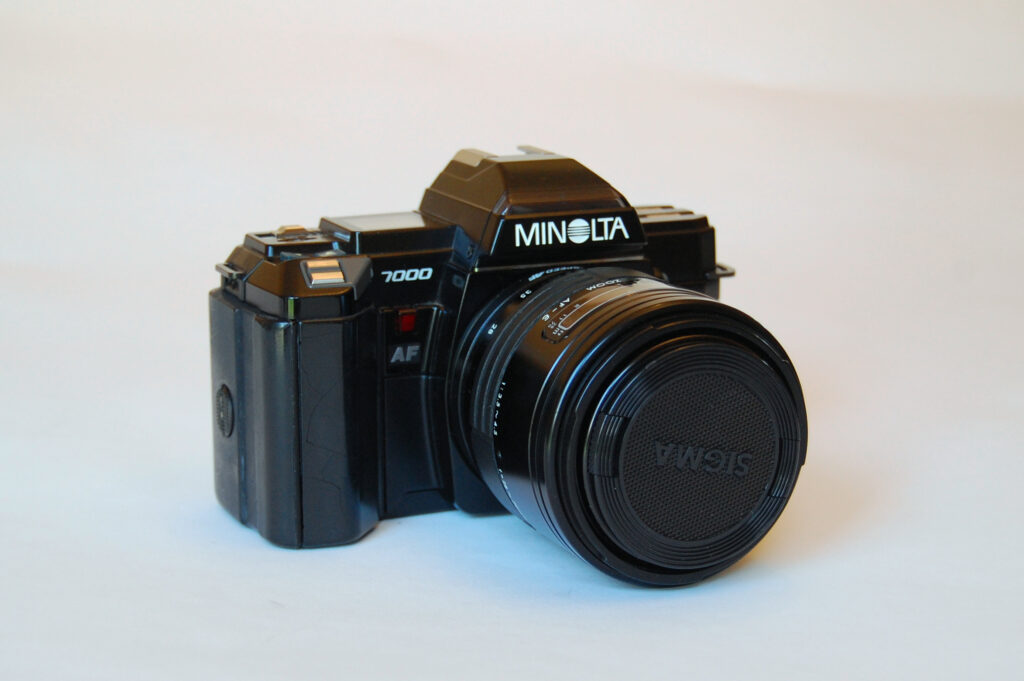
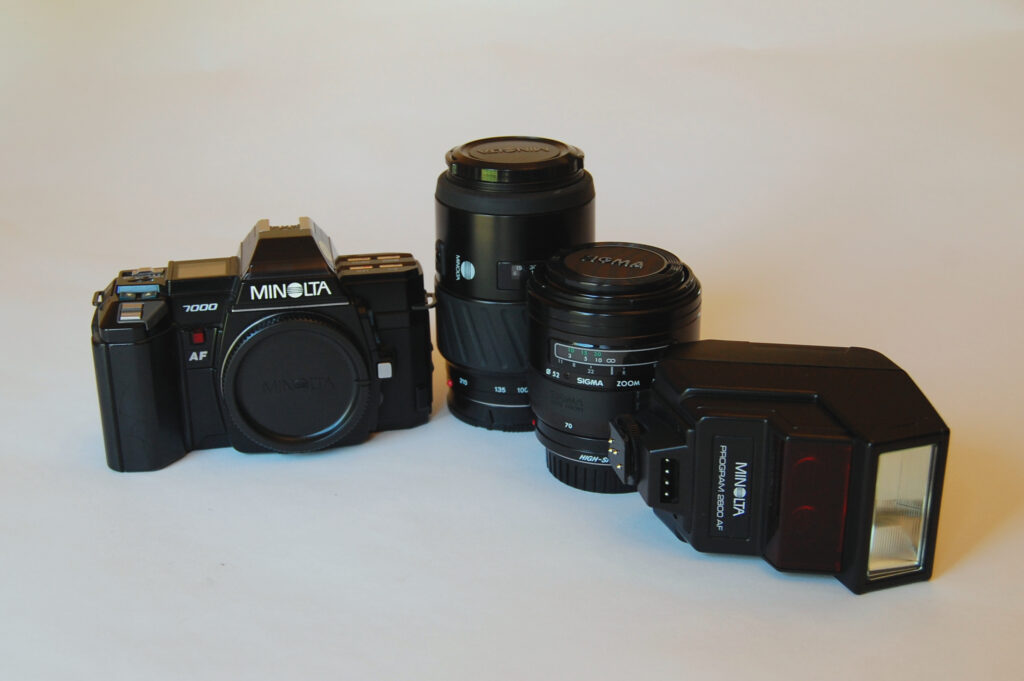
The Camera & Equipment
Untested, the camera, along with a couple of lenses and a flash, had cost me €30 on Kleinanzeigen, Germany’s eBay or Gumtree. It had seen some use during short trips, but I was yet to find its niche. Offering autofocus, electronic film advance and a program mode, it had felt a bit boring and underutilised taking vacation photos. On top of that, the early autofocus system makes the camera and lenses bulky. It feels like a high-quality machine intended for shooting difficult subjects in difficult conditions. De Ronde, then, would be a great first test: racers travel at minimum at 45kmh and beer, rain and flare smoke would fill the air, offering the Maxxum a real challenge.
The lenses included in the €30 were a Sigma 35-70mm f3.5-4.5 and a Minolta 70-210mm f3.5-4.5, both of which worked perfectly. I took the Sigma with me to Flanders as I wanted a mid-range zoom. I didn’t know how close to the race I would get so carrying both would have been ideal, but I was just trying my hand at photographing sports and didn’t want to carry an extra lens.
I took only two rolls of film with me: one Ilford HP5 36exp and one Kodak UltraMax 24exp. De Ronde is often photographed in black and white to evoke the storied history of a race that was first run in 1913, so I wanted to see if the use of black and white film could do an even better job of highlighting how much the race has in common with its earlier iterations. The Kodak UltraMax was a no-brainer: the environment is generally green, brown and grey, the weather would be cloudy with a chance of rain, and I wanted vivid colour for the rider’s team outfits.
B&W
After a few hours on the train and a bit of a hike, I got a nice spot on the edge of a field raised above the cobbles of the Oude Kwaremont, a hill which promised to help decide the race. I was about two metres above the race and four metres from the road, offering a good perspective and chance to include other fans in my photos.
I began by taking black and white photos of the atmosphere around me and some groups of spectators: local soccer supporters, there to scream on anyone from Flanders, clashing with a group of French supporters across the road, the numerous people climbing into muddy ditches next to the road (unfortunately no photos of the ones who fell are included here), and the surprising number of very loud and very proud Basque fans.
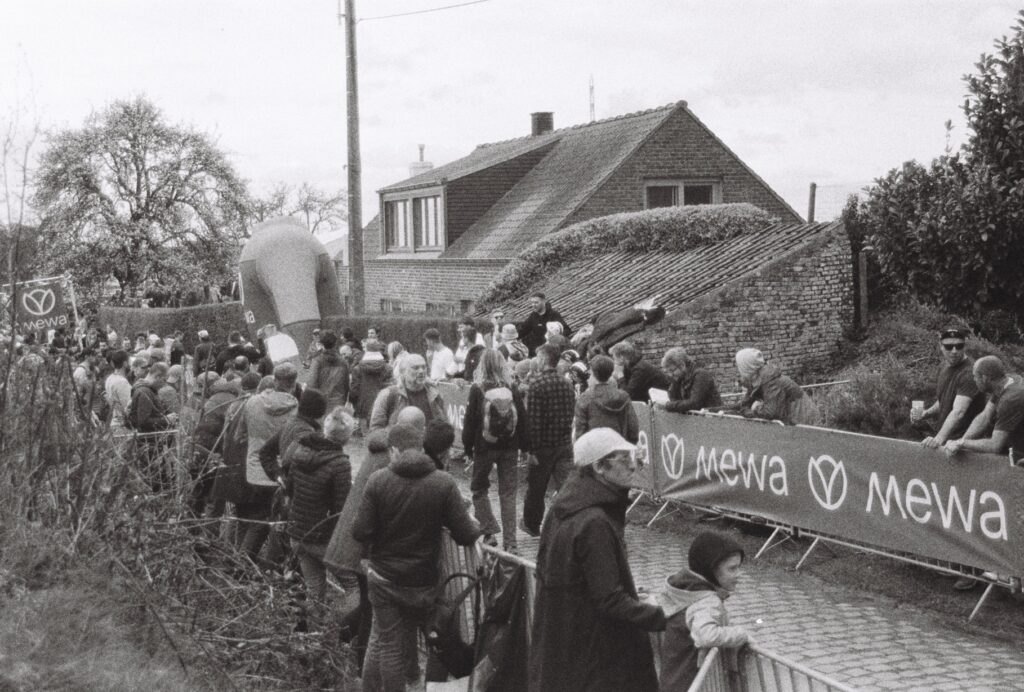
Not many of these photos turned out well: it shows that this was my second time shooting black and white. I didn’t consider my medium well when choosing my subjects, resulting in photos that would likely have had more significance if shot in colour. I at least cannot fault the camera here – they are well exposed and camera was operating perfectly.
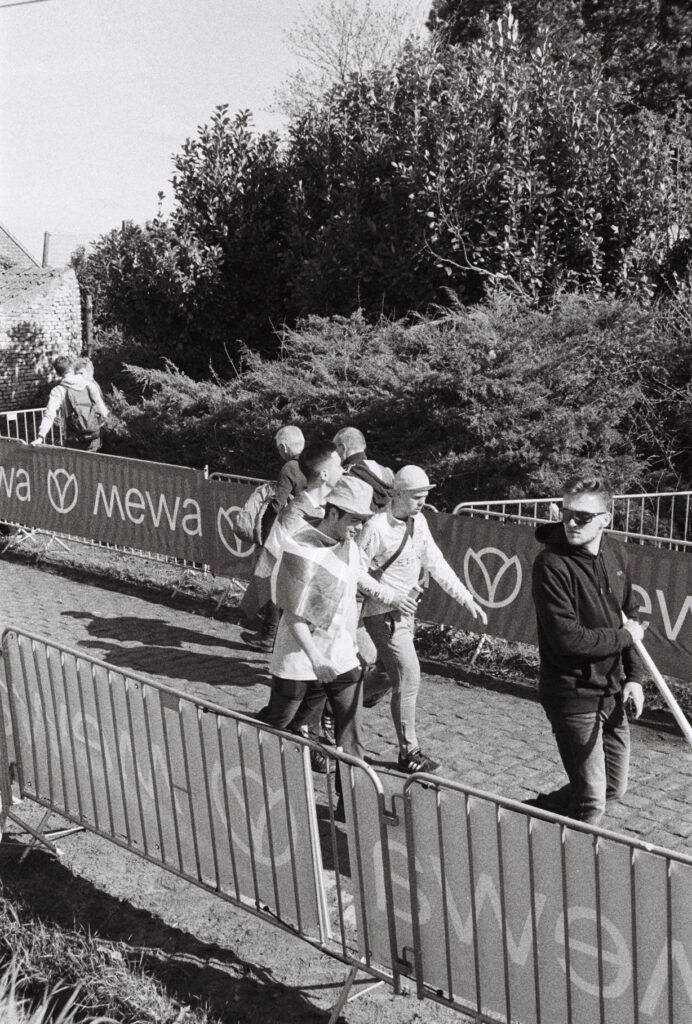
Photos such as this one of a group of Basque supporters walking up the road lose significance because their flag colours are not clear.
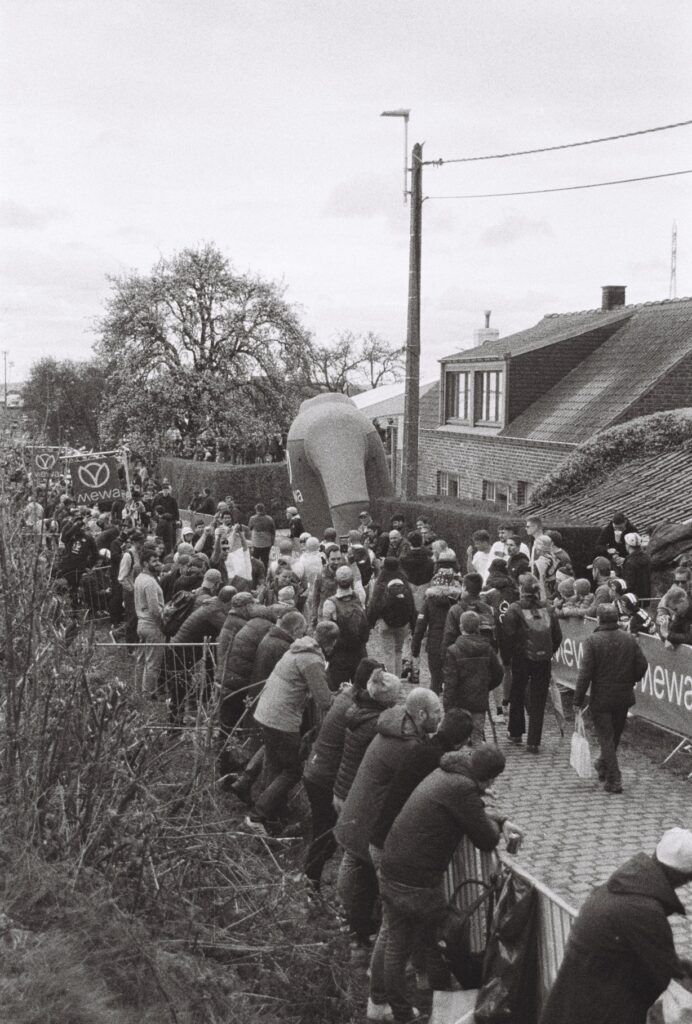
Others were a bit better: this one has some informative value showing the size of the crowds and the people getting out onto the road to feel the cobblestones under their own feet before the race came through.
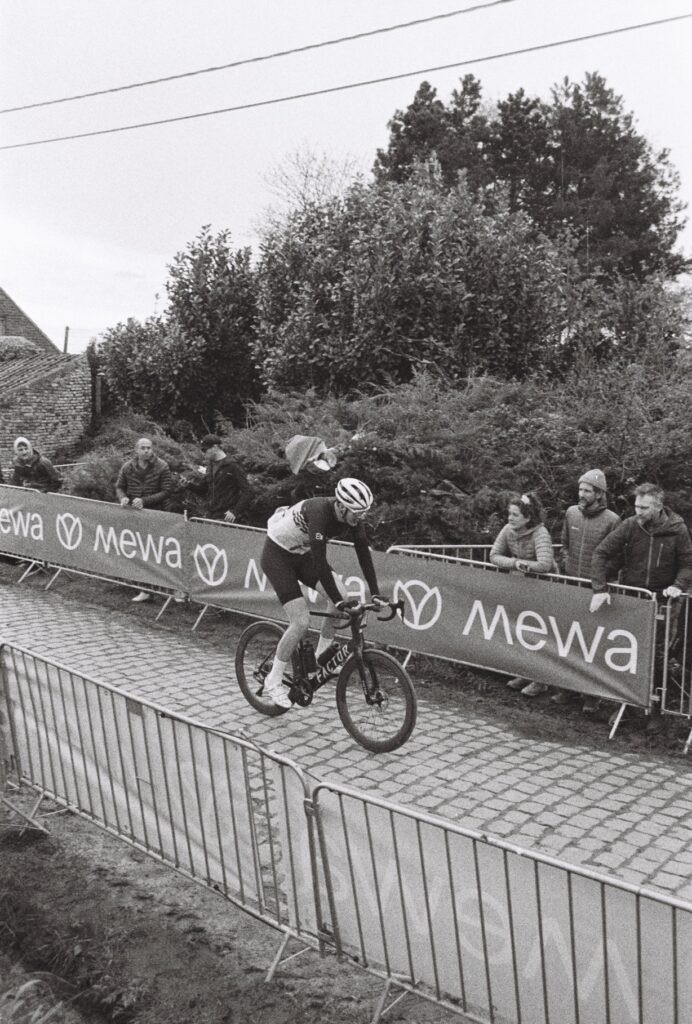
A lone civilian rider goes past in front of the race getting a feel for the cobbles. I would’ve liked to get closer in on his facial expression, but some level of pain still seems to be evident from this distance. I had begun to question my lens choice a bit. I would find later that I could get individual shots of riders, if not of facial expressions, from the position I chose. I think overall I had made the right choice – if I hadn’t had the option to go down to around 35-50mm I would’ve struggled to get photos of the peloton with context.
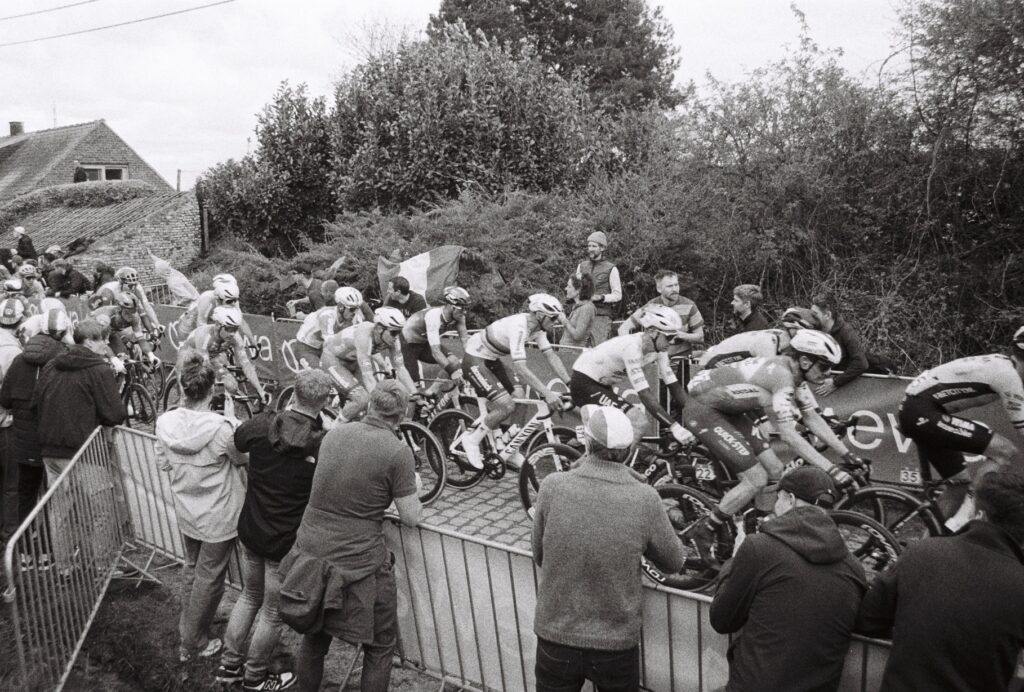
The professionals then began coming through for the first time: pictured here is the main peloton before the group splits up. I like this photo most out of the black and white images I took. The recognisability of riders relies heavily on the colour of their kit because of the helmets, sunglasses and lycra – on such a grey day the HP5 removes a lot of this individuality. This helps to communicate the sensation one gets of the peloton being a swarm of flies darting past at pace, emphasised by the buzzing noise of their freehubs. One rider stands out in the middle of this image in the white jersey with multi-coloured bands: Mathieu van der Poel, who had won the race twice previously. Watch out for him in later photos.
Colour
I switched now to a roll of UltraMax 400. I had come to the race unsure about the autofocus on the Maxxum, since the riders would be moving quickly. It had surprised me in the best way possible, deftly choosing the correct subject. I had my shutter speed set to 500 most of the time to avoid blur and the camera was choosing apertures well.
Around this time, it also started raining and the crowds became bigger as the end of the race approached. The rain was still light, so I tucked the camera under my jacket most of the time and took it out only when the race passed. Despite the lack of weather sealing, the Minolta coped well with short exposure to drizzle while I shot in bursts, relying at times on the very capable two shot per second continuous mode. Nor did it flinch at being opened up in the rain to change the roll of film – it was proving itself to be the tough companion I had hoped.
The photos I took from here on do a much better job of capturing the chaos of a bike race: while the black and white shots turned the peloton into a single swarm, the colour highlights how the race had become more strung out and the riders more at odds with one another.
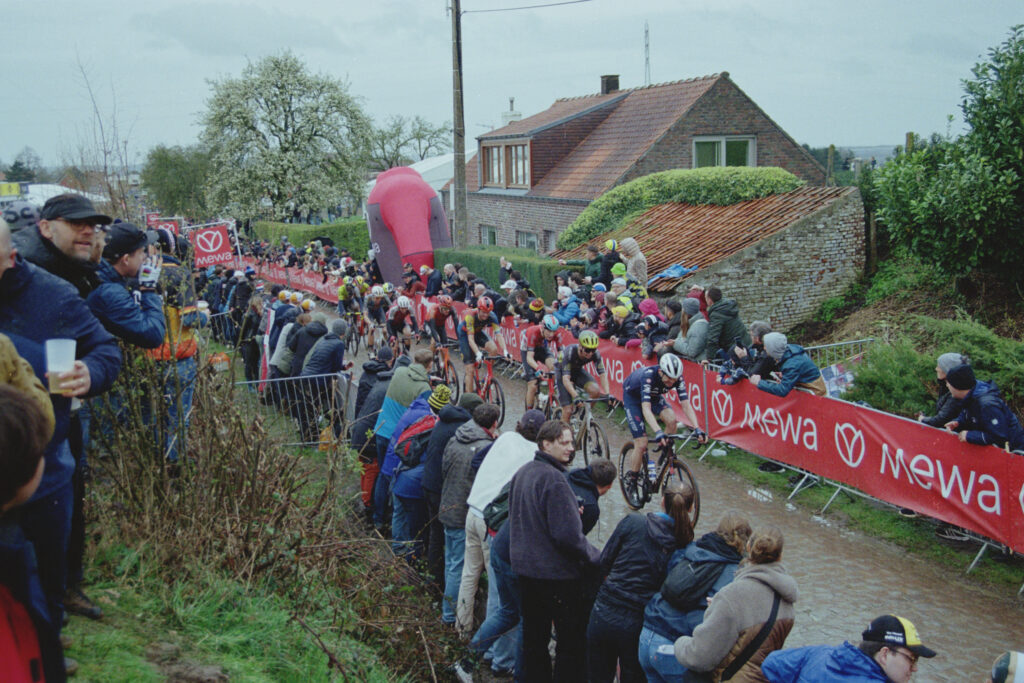
I like the lines of this photo: the riders stretched out blend into and are shrouded by the lines of crowd and barriers and appear to be racing to escape this envelopment. The spectators on the left either look ahead to the riders being chased by this group, yell at the racers or share a beer with their mates. The traditional angular Belgian farmhouse is juxtaposed with the fat inflatable jersey to its left, a staple of European cycle racing advertisement placement.
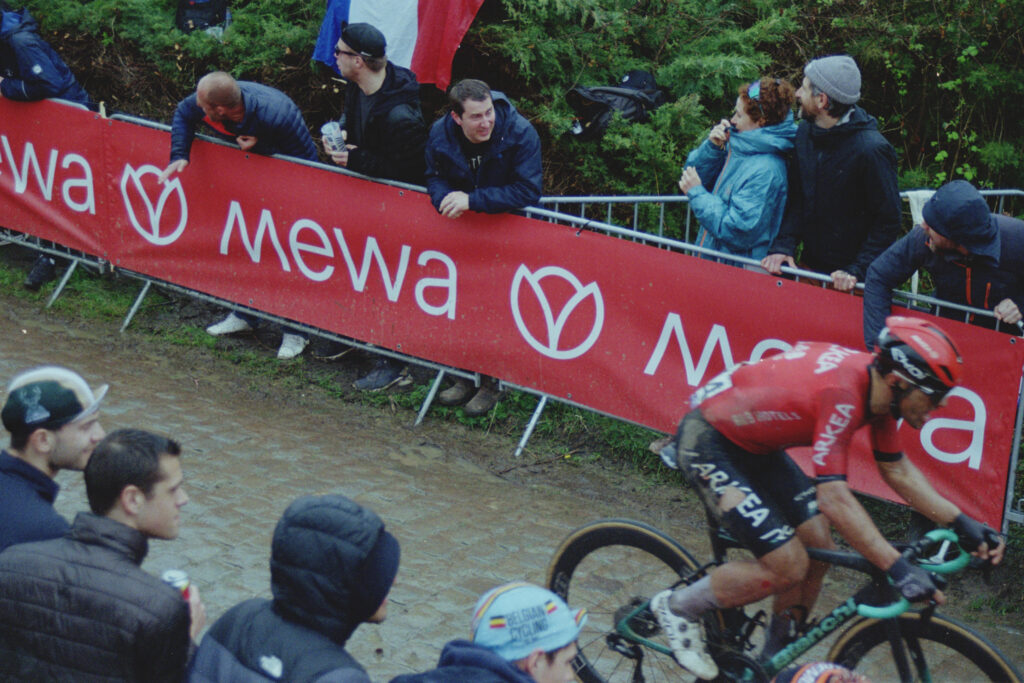
Here a single French fan cheers on a rider from a French team even as his compatriots turn their attention back down the road. The muddied and ripped shorts and small spot of red on the knee tell of an earlier crash, a common occurrence in the chaos of De Ronde.
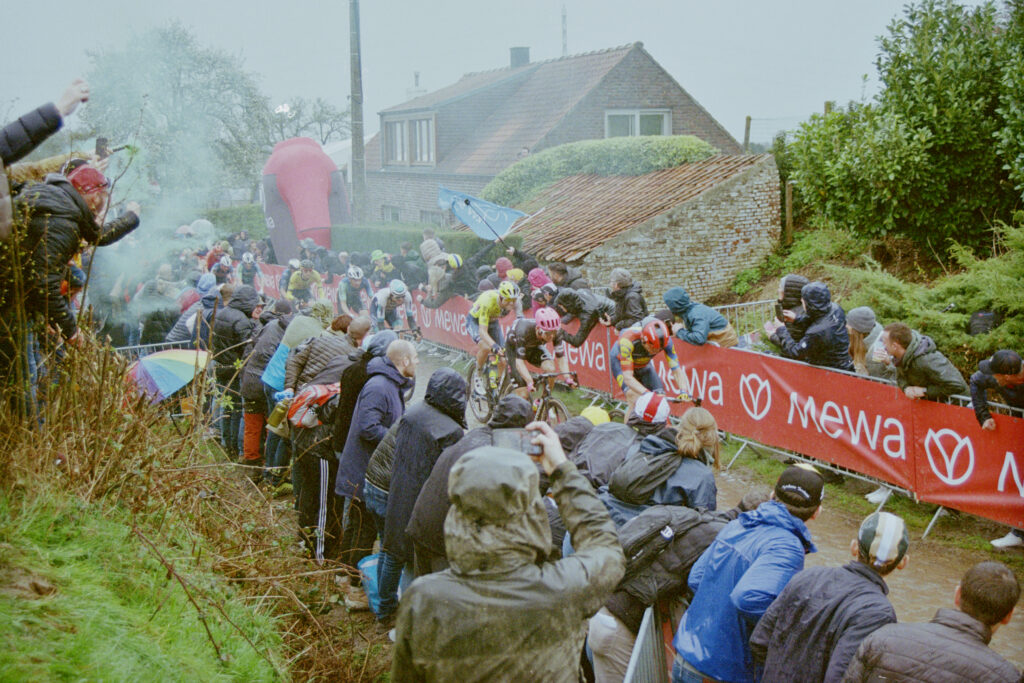
A typical feature of European cycling spectatorship: the flare. The riders appear through the green haze into a new haze of noise as people clang cowbells and clackers, and scream. Drably outfitted fans take up any place they can to support. My fear that the smoke haze would confuse the camera’s autofocus or exposure selection proved to be unfounded: the camera exposed well here and the colours are as vivid as I’d hoped.
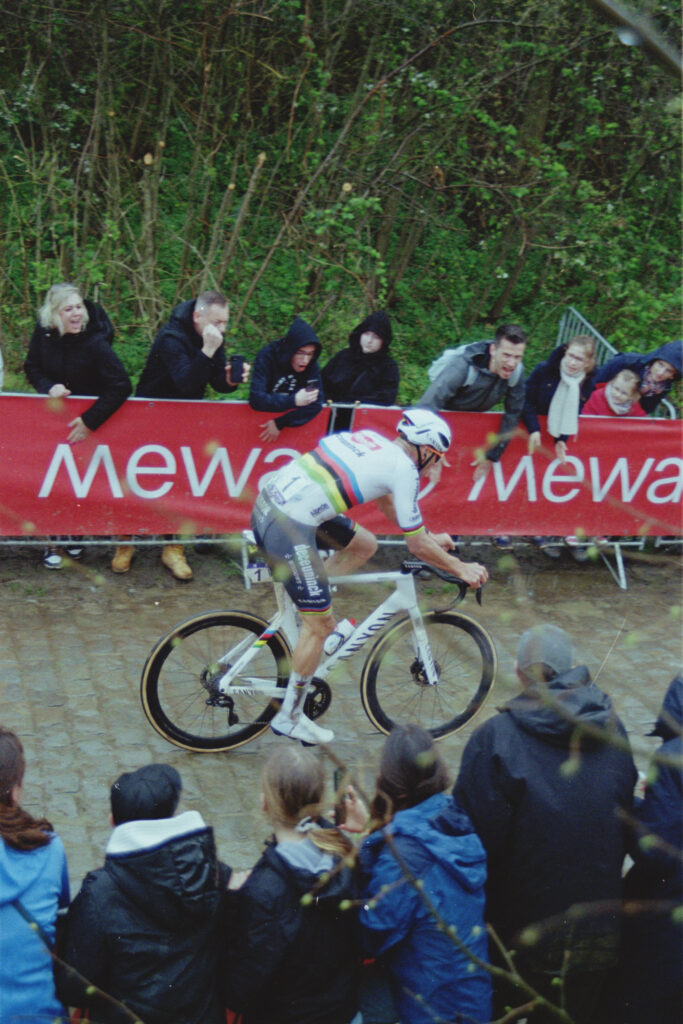
Finally, the man of the day: Mathieu van der Poel would go on once again to dominate the race with a decisive lone attack from 43km out from the finish. This accidentally over-exposed photo appears to give him a white aura, highlighting what some consider an almost other-worldly ability in the mud and rain of the Belgian classics.
I came out of this experience stoked with the performance of the Minolta. The auto-focus chose well, the shutter fired true and the camera selected appropriate apertures. All of my concerns about smoke, weatherproofing and dealing with fast moving subjects had been completely disproven. It offered something completely new to the market when it was released and is full of complex electronics, and yet, it still functions perfectly: the only maintenance I had to do after buying it was to clean out the battery terminals. I was amazed, having underestimated it massively.
I also learnt a lot personally. I would’ve liked to get some closer-up shots of riders showing the mud and pain on their faces, the wounds on their bikes and bodies and the size of the cobblestones. I could’ve done this best by getting closer, down near the barriers, but doing so poses risks: too many videos exist of fans with cameras and phones hitting riders and causing crashes, especially on roads as narrow as these. Maybe a longer lens next time?
Share this post:
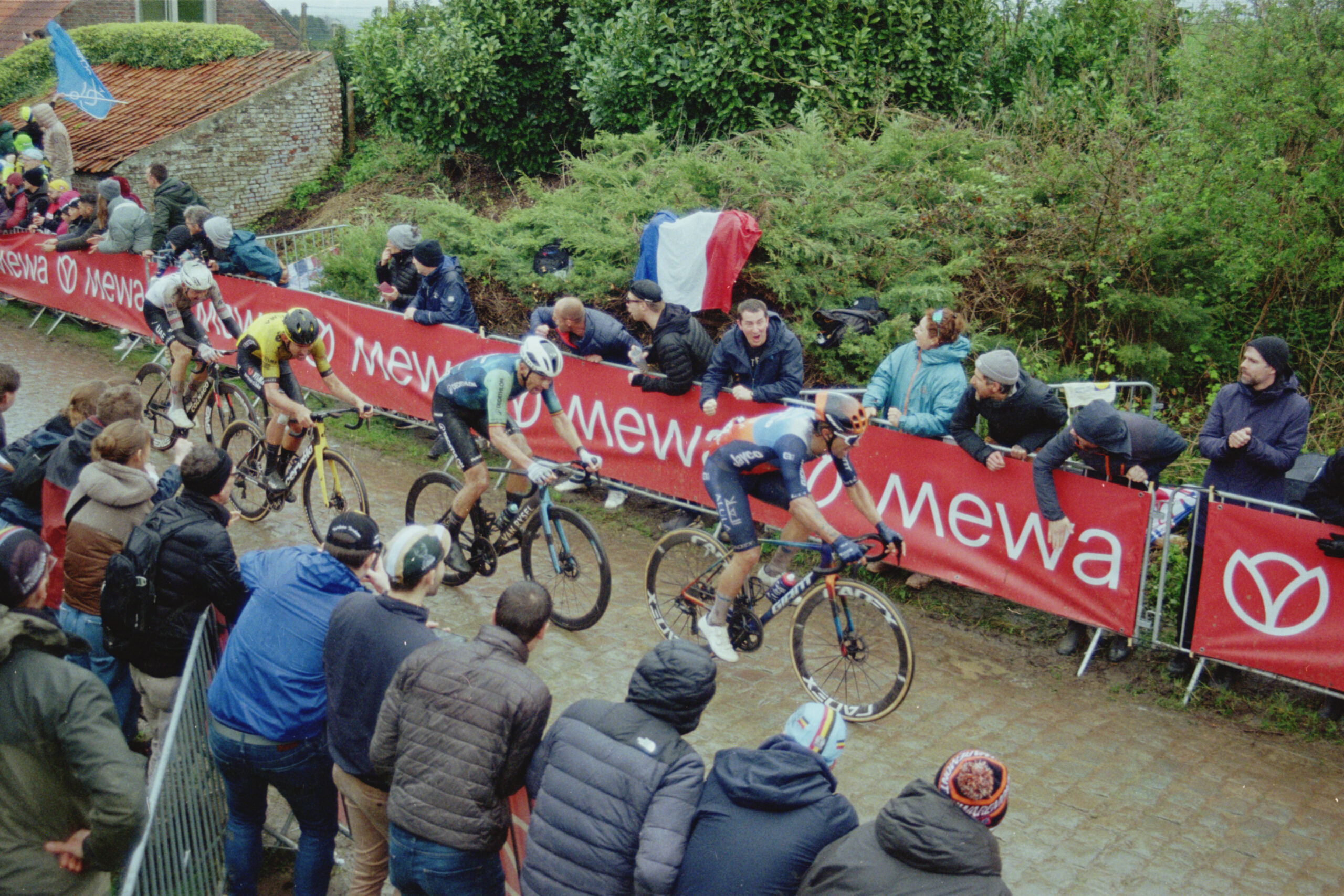
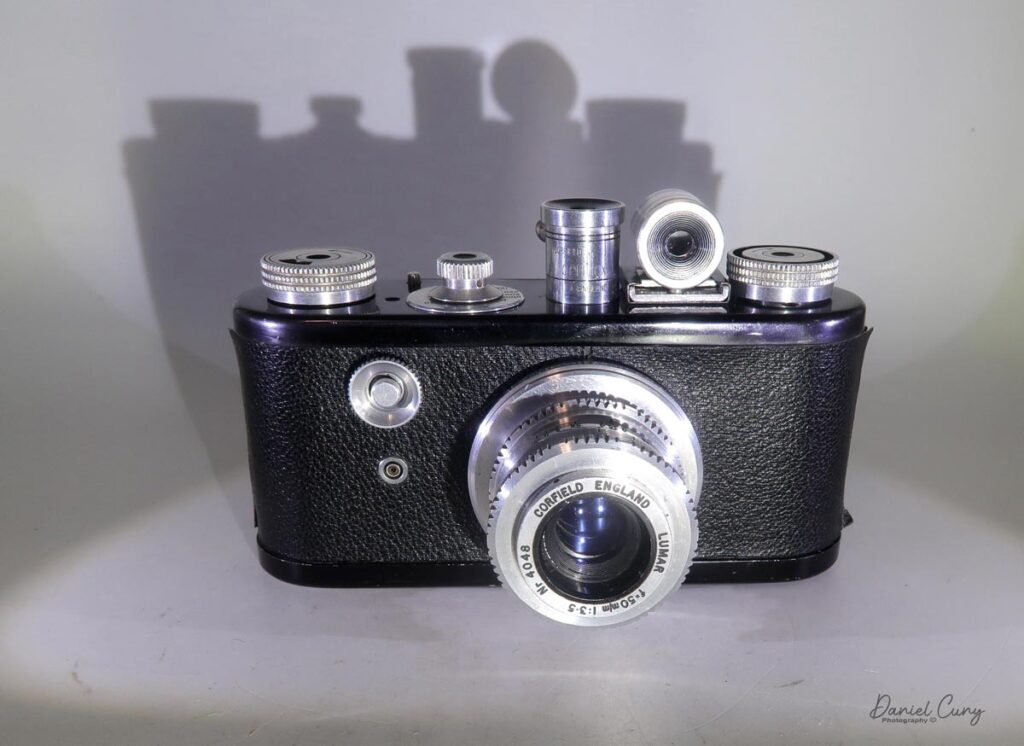
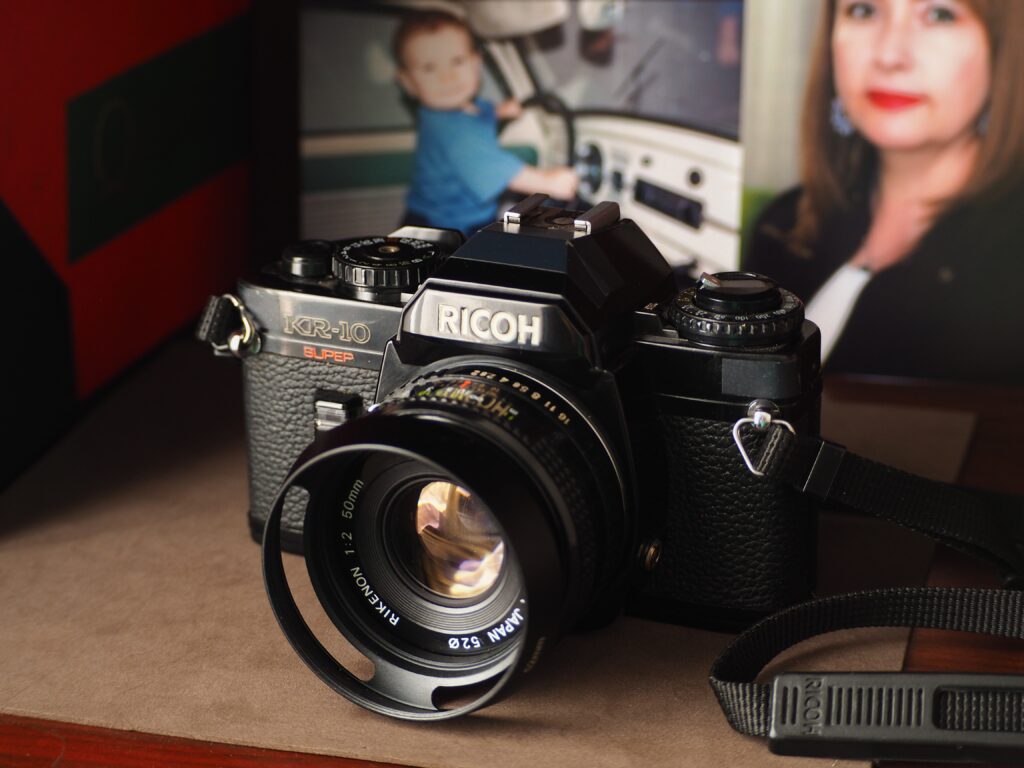
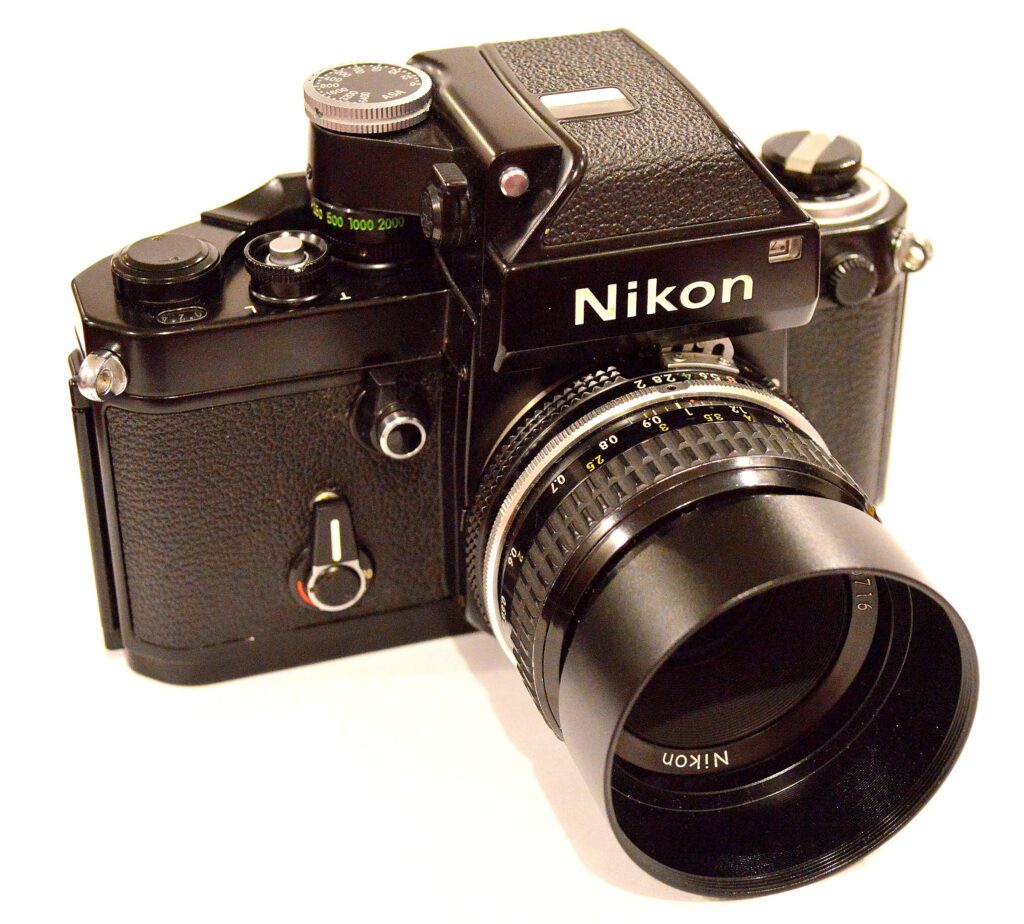
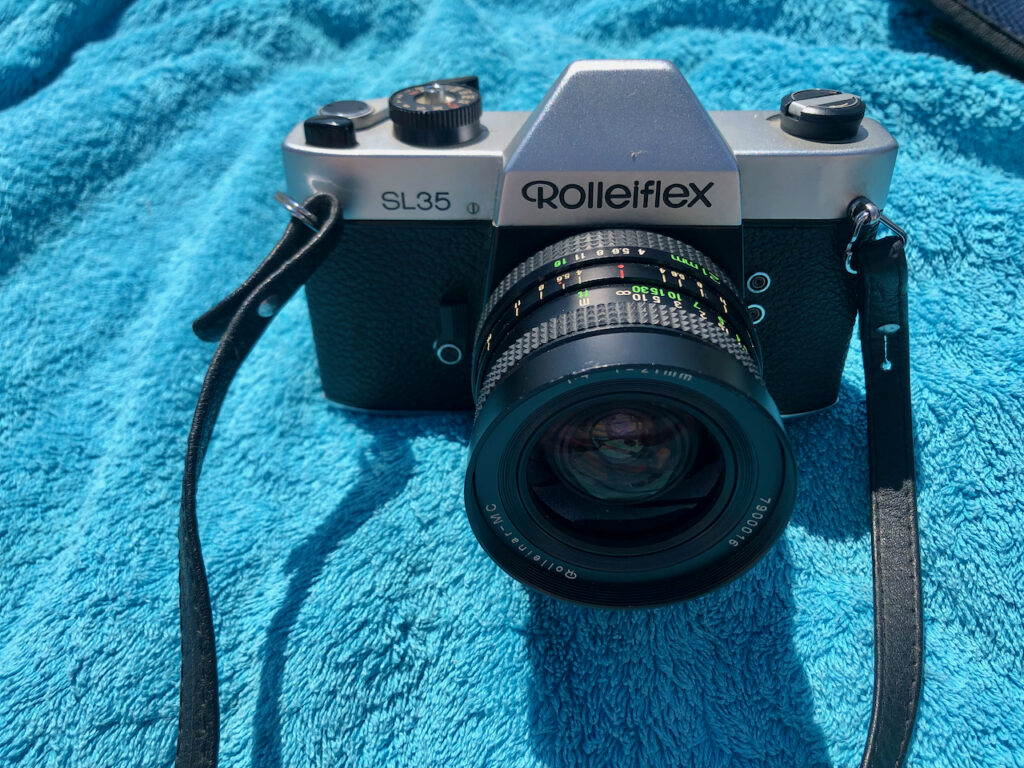




Comments
Geoff Chaplin on Minolta Maxxum 7000 – Putting a €30 Camera Through Its Paces at Belgium’s Toughest Cycling Race
Comment posted: 13/11/2024
Comment posted: 13/11/2024
Chris on Minolta Maxxum 7000 – Putting a €30 Camera Through Its Paces at Belgium’s Toughest Cycling Race
Comment posted: 13/11/2024
I guess you shot the HP5 at box speed, which is "kind of" a no-go for HP5. Usually i shoot HP5 at 800 or 1600 (1-2 stops underexposed) to later push 1-2 stops in development. HP5 is very versatile and produces great results when being pushed.
That's why I also like the colour shots more. But all in all I would say a successful first test for your new camera and to get used to the Minolta shooting experience ;)
Comment posted: 13/11/2024
CHRISTOF RAMPITSCH on Minolta Maxxum 7000 – Putting a €30 Camera Through Its Paces at Belgium’s Toughest Cycling Race
Comment posted: 13/11/2024
Comment posted: 13/11/2024
Francois Marlier on Minolta Maxxum 7000 – Putting a €30 Camera Through Its Paces at Belgium’s Toughest Cycling Race
Comment posted: 13/11/2024
Comment posted: 13/11/2024
Gus on Minolta Maxxum 7000 – Putting a €30 Camera Through Its Paces at Belgium’s Toughest Cycling Race
Comment posted: 14/11/2024
I still struggle (but love!) black & white, sometimes it’s surprising what is muted (like the colored flags) and what pops out (MVDP). I really enjoyed the photos.
I’ve been experimented shooting our local races. I’ve had recent success using slightly slower film (FP4), rear-sync flash, slower shutter speeds (1/60 to 1/250) and panning as the riders go by. It gives a sense of speed (by blurring everything except the riders).
Comment posted: 14/11/2024